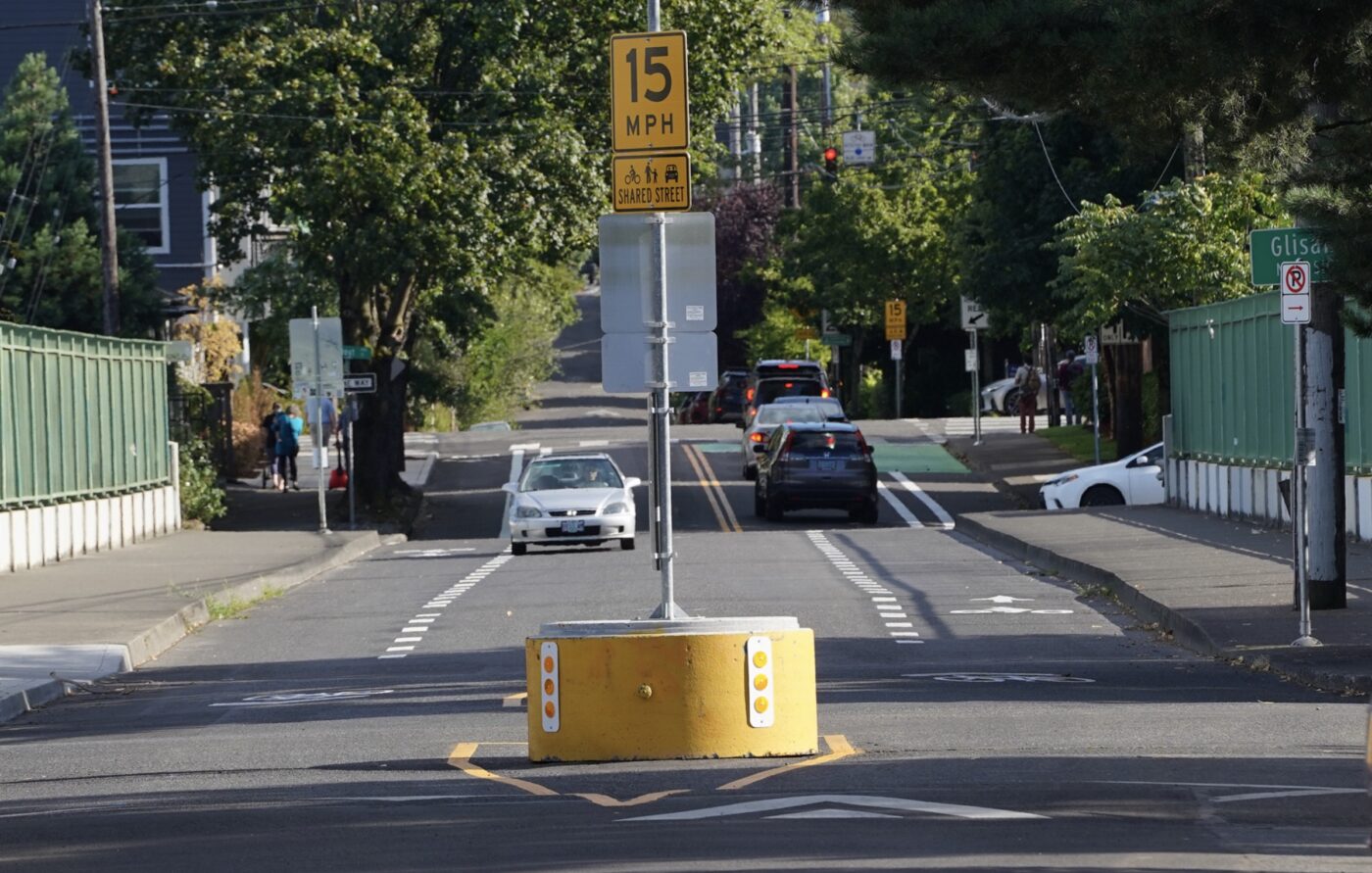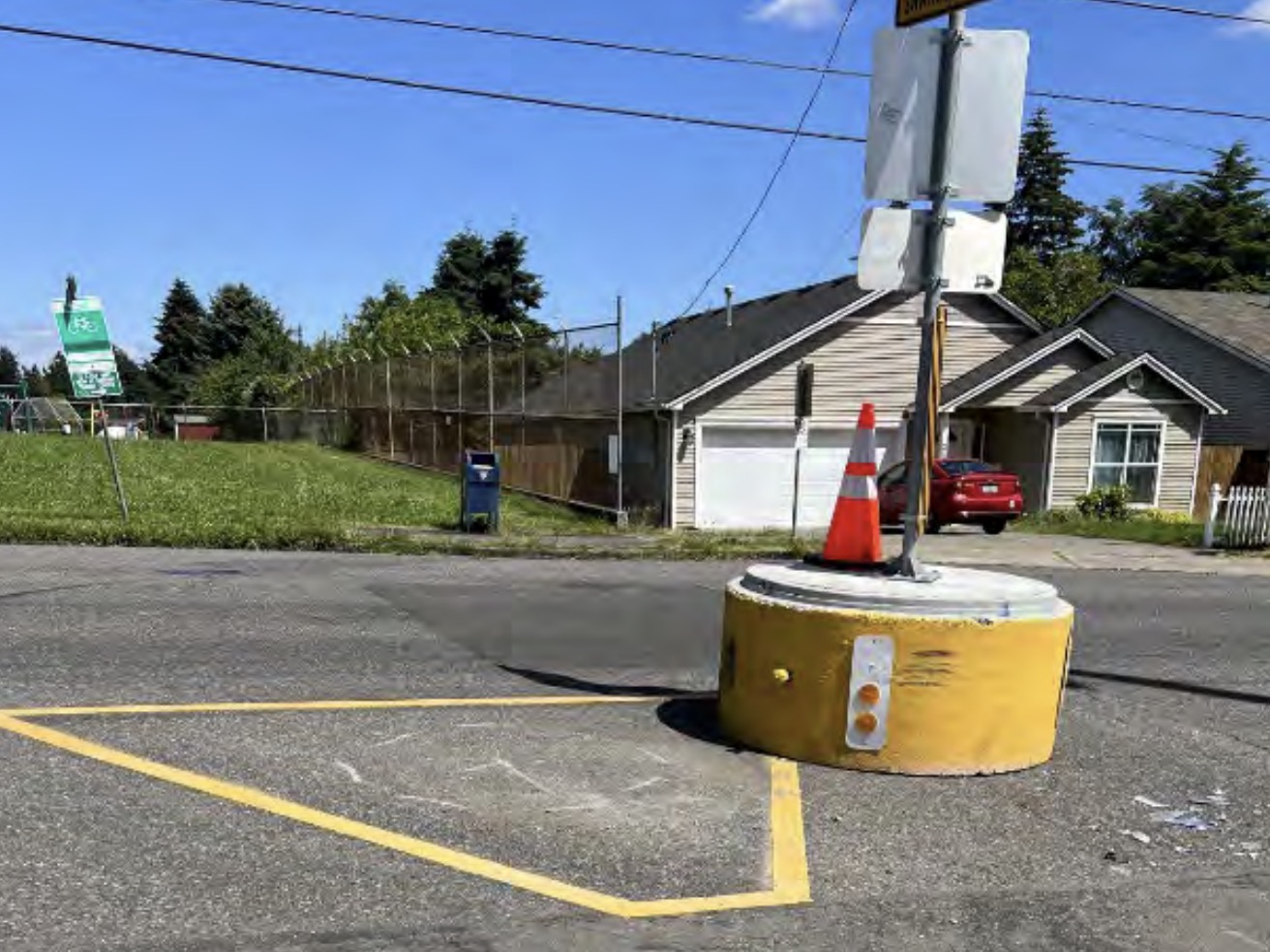
The City of Portland is removing traffic-calming infrastructure because drivers run into them too often. While that might seem like success to some, continued clashes between car drivers and concrete planters has led to high maintenance costs and transportation officials say it’s not worth the effort.
Several readers have reported to BikePortland recently that the large, round, concrete planters installed on bike routes throughout the city have gone missing. When the first batch of these were installed in 2021, we said they were a very big deal because their size and stature seemed unavoidable and it was a relatively bold safety move by the Portland Bureau of Transportation (PBOT).
The round, 2,500 pound planters filled with concrete were installed at strategic locations to protect bike lanes at conflict points, to reduce speeds and lower car traffic volumes on neighborhood greenways and other key bike routes. They would often come with yellow advisory 15 mph “shared street” speed limit signs and reflective material to enhance their impact.


These planters emerged from PBOT’s Slow Streets Program which began in May 2020 during the Covid pandemic with flimsy signs and orange plastic barrels placed in streets at 200 locations. The idea was to calm drivers and improve safety for walkers and bikers during a crisis when Portlanders needed more outdoor, Covid-safe public spaces in a hurry. In 2021, PBOT opted to make 100 of those locations permanent, using more robust materials in hopes they’d require less maintenance than the signs and plastic barrels.
But that’s not how things have turned out.
In May of this year, Portlander Ted Timmons (and amateur pilot and aerial photographer) emailed 311 (311@portlandoregon.gov) to report one missing near his home in the North Tabor neighborhood. “Until recently there was a large concrete planter on NE 53rd near Irving,” Timmons wrote. “It is gone. What happened? Will it be replaced or is it permanently gone? I own a house within sight of it, and I really appreciated how it helped with traffic calming.”
A few weeks later, Timmons received a response from PBOT Bicycle Coordinator Roger Geller, telling him it was removed, “due to excessive maintenance issues.” “It kept getting hit,” Geller wrote. “Which created a consistent maintenance burden for PBOT staff. In the future, there may be other more permanent improvements that can be installed at this intersection but there is nothing identified yet.”
The planter at NE 53rd and Irving was installed in 2022 to calm traffic near one of PBOT’s advisory bike lane installations.
A month after Timmons emailed, I heard from reader Chris H. He noticed planters had gone missing in two locations along the North Central Avenue neighborhood greenway (at N Richmond and N Chicago). Chris emailed PBOT’s Geller to ask where they’d gone. Geller offered the same response he gave Ted T, and then added, “The concrete planters were installed in large part to reduce maintenance issues with the plastic orange barrels that were initially installed in May of 2020. Unfortunately, the tight turning radius created a consistent maintenance burden for PBOT staff.”
Chris called the decision “discouraging and frustrating,” and wrote to Geller that he’d be forced to, “avoid N Central during commuting hours from now on.”
The decision to remove these planters wasn’t Geller’s alone. The May 2024 Slow Streets Draft Evaluation Report (PDF) released by PBOT says despite being popular with the public, the program wasn’t effective at calming traffic, and some locations were hit so many times by car users it drained maintenance resources.
“Overall, speed and traffic volume changes were mixed making it difficult to attribute any changes in traffic operations to the Slow Streets program,” reads the draft report. And from a roadway design perspective, the report says the goal of converting 100 locations to more permanent treatments might have been too ambitious and didn’t allow PBOT engineers to do thorough site analysis for each one. (As of May 2024, PBOT says 62 locations have been converted.) “The wide-spread approach led to some locations with unexpected operational issues that required significant maintenance to correct. Individual site assessment by engineering staff will help avoid future maintenance issues,” states the report.
The original “a-board” signs and orange plastic barrels were moved so often, PBOT contractors had to make weekly (and often more frequent) site visits to put them back in place. PBOT assumed 2,500 pound concrete planters would fix this problem. Turns out they underestimated the force and frequency with which some drivers’ cars hit them.
According to maintenance records, in the 20 months between July 2021 and April 2023, PBOT fielded 75 requests for upkeep at 55 locations. 60 of those requests required two PBOT maintenance workers to respond with a winch-equipped vehicle or small forklift to move the planters back into place.
With high maintenance costs and inconclusive data on speeds and traffic volumes, PBOT’s report says their Slow Streets infrastructure is “not impactful” and they prefer more traditional traffic calming methods like diversion and speed bumps.
PBOT’s conclusions in the report were likely influenced by a directive (PDF) from City Traffic Engineer Wendy Cawley. Effective March 11, 2024 Cawley called out a variety of temporary materials PBOT uses — including “planters” and “paint and post installations” — and said staff are no longer allowed to use them without prior approval and they can be used only in limited situations.
“Temporary materials require more maintenance than permanent infrastructure when left in the field for long periods of time,” the Cawley memo reads. “PBOT is facing a fifth year of budget cuts and cannot afford to reliably maintain temporary materials/infrastructure at the current level of usage. Additionally, the aesthetics of temporary materials do not support the vision for Portland that City Leadership and Portlanders have.”
If concrete planters are used, Cawley says they, “must be protected by concrete curbing to minimize vehicle strikes and the need to reset or move materials back into place.”
While PBOT has cooled on Slow Streets-style installations, the public seems to have loved it. PBOT received over 2,000 comments about the Slow Streets Program and presented about it to over 50 neighborhood associations. PBOT says the comments were “overwhelmingly positive” and “staff consistently heard that Slow Streets had a positive impact on Portland streets and communities.”
Overall, the signs and planters have functioned well as gateways to greenways and in helping raise awareness of safer bicycle routes and the people who use them; but PBOT believes they haven’t worked as a permanent traffic engineering solution.
To effectively calm Portland streets it will take an even more robust approach from PBOT. And they say they’re ready to do it with more engineering analysis and more permanent infrastructure, as long as they can identify the funding to make it happen.
Learn more:






